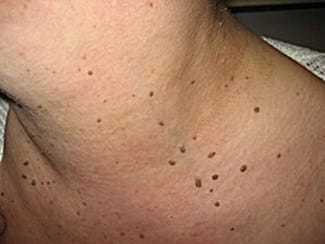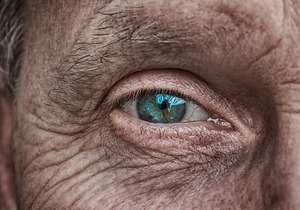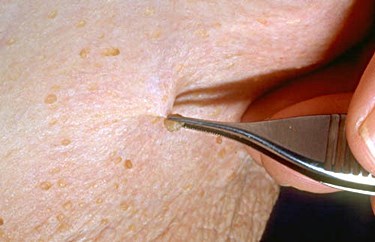
The most common reason for skin tags around the neck is believed to be skin-on-skin friction. Skin irritation can cause the cellulite in the skin to change the structure. This can happen regardless of whether the ‘irritant’ is jewelry, clothing or skin.
However, there are many explanations besides just friction. In general, medical conditions that affect the body’s control of the skin is thought to play a hand. These range from genetics to hormonal fluctuations, and obesity to type 2 diabetes.
Our guide will help you identify the reason for skin tags on the neck. We also recommend specific treatments for neck skin tags. Altogether, this guide provides you with everything you need to know about what causes skin tags, how to remove them, and much more.
How to Identify Skin Tags around the Neck
If you have no experience of having skin tags, you may be confused at first. But it’s relatively easy to identify them if you know what to look for.
Here’s how to quickly tell them apart from other skin conditions:
- Skin tags are soft outgrowths of skin, which hang over the skin on the end of a stalk.
- They are small (3mm to 5mm), but skin tags can grow larger (to the size of a grape).
- Skin tags are usually the same color as your skin but can vary by a few shades.
- They mostly occur around the neck, eyelids, armpits, and groin. The most likely places to find them are in and around skin folds.
- Unless there is a source of irritation or infection, they shouldn’t cause you any pain.
Skin tags rarely change color, but it can happen. You may find that an irritated skin tag on the neck becomes blood-filled or turns black. You shouldn’t attempt to remove a reddened skin tag until the infection has cleared up.
Black or purple skin tags are likely to fall off on their own after a couple of weeks. This typically occurs when oxygen isn’t reaching the tumor. It cannot survive without a supply of oxygenated blood.
What are the Causes of Skin Tags Around the Neck?
There are a number of causes, one or more of which may have caused you to develop skin tags. Friction is a common reason, but the picture may be far more complicated. The truth is that it could be many factors that have caused skin tags to develop.
Before we dive in to consider what causes them, there’s one thing we should say. Even though scientists have been able to identify some of the reasons, they are not well understood.
Let’s take a look at some of the most common reasons:
Skin Rubbing Against Skin, Jewelry or Clothing
The main reason they are thought to be caused by friction are the locations they are commonly found. They are located under the armpit, around the eyes, and underneath the fold of the buttocks.
The anatomy of a skin tag is fairly simple. Regular skin cells become stretched and elongated, whether by a lack of elastin in the skin or because of friction. So we could expect to find large numbers of skin tags anywhere where your skin is consistently rubbed.

This is especially the case for skin tags around the neck. Anybody who wears a necklace will experience it rubbing against the skin, which can be uncomfortable. Not to mention that everybody has to live with a collar and tie around their neck due to their professional occupation.
The friction that clothing and jewelry around the neck cause is perhaps the most common reason why this skin condition occurs. And for overweight individuals, the extra skin around the neck can play a role too. All of these factors add up to make it a widespread skin complaint.
Hormonal Fluctuations
Aside from friction, hormonal fluctuations and imbalances can cause a skin tag growth to form on the neck. Hormones play a central role in our lives, and their effect on our skin cannot be understated. Since they affect every part of our body, it is little wonder that they can cause skin conditions, too.
We all know the role that hormones play in our lives. They define everything from our behavior as teenagers, all the way through to old age. So, even though we aren’t sure exactly how hormones influence us and influence each other, it’s believed that they cause neck skin tags, too.
Scientific studies are increasingly pointing to the effect that hormones have on the skin. Leptin, which is normally associated with weight gain, also seems to influence skin tag growth. While leptin is to help your stomach understand when it’s full, it might also have some ‘side effects.’
Having too much leptin in the body can cause insulin resistance. Insulin resistance and diabetes are another cause of skin tags, which is a point we will return to soon. None of these hormonal changes are clearly understood.
Another hormone known to increase the number of skin tags developing around your neck is estrogen. We already know that declining estrogen in the body causes the skin to become oilier and less elastic.
Hormonal Fluctuations Associated with Pregnancy
As we’ve already pointed out, pregnancy causes fluctuations in estrogen. But you probably already know that pregnancy involves a far more complex hormonal cocktail.
Here are five of the most interesting hormones associated with pregnancy which affect the skin:
- Progesterone helps your muscles to relax during pregnancy and birth. It causes all sorts of odd symptoms like excessive gas and morning sickness. And it’s also responsible for unwanted hair around your body. It can also cause sebaceous fluid, which causes acne. That’s a sign of how pregnancy hormones don’t just affect what’s under your skin, but your skin itself.
- Oxytocin, or the ‘love hormone,’ helps you to bond with your baby immediately after birth. But like all hormones, it also has other effects! It modifies the response of human skin cells to stress and touch.
- Human chorionic gonadotropin, or HGC, is produced by the placenta during pregnancy. If you’ve ever heard of it, it’s either because you’re a biologist or you know that it’s what pregnancy tests look for to prove that you’re pregnant. HCG helps improve blood flow to the skin, which is what makes pregnant women ‘glow’. But whether your skin looks better or worse, is all down to luck.
- Relaxin yet another muscle relaxant hormone, essential during pregnancy and childbirth. According to the Society for Endocrinology, there’s some evidence that relaxin can cause scleroderma, a condition where the skin thickens and hardens.
- Prolactin is a hormone that is made in the pituitary gland and the levels of this hormone increase in pregnant women or those who have recently given birth. This hormones effects on the skin have yet to be studied fully, however, they may find a prolactin circuit that exists between the central nervous system and our skin.
Looking at the evidence, it’s no surprise that pregnancy causes skin tags around the neck.
Weight Gain or Obesity

Another precursor to skin tags is weight gain or obesity. If you’ve recently gained a lot of weight, or you’ve held onto weight for a long time, you may have started to develop skin tags.
There are three excellent reasons why weight gain or obesity can cause skin tags to form. The first is that, as we’ve already established, friction can cause skin tags appearing around the neck. The increase in two areas of skin rubbing together due to excess weight is a common cause.
Second, weight gain causes hormonal imbalances. And as we’ve already seen, hormones work in strange ways, having side effects almost like pharmaceutical drugs.
PCOS, polycystic ovary syndrome, is caused by hormonal imbalance from the excess fat tissue.
Obesity also causes the body to produce extra androgens, a hormone similar to estrogen. And lastly, diabetes and insulin resistance cause skin tags too. But from all these points, it’s no wonder that gaining weight quickly can cause skin tags.
Insulin Resistance or Type 2 Diabetes
Skin tags can be irritating at the best of times. But if you’re suffering from diabetes or insulin resistance, they’re the last thing you want. Unfortunately, studies have found a link between the two.
Even besides the link between obesity and Type 2 diabetes, insulin resistance will cause skin tags formation thus skin tags on the neck can be a sign of diabetes. Scientific studies show that as a general rule, the more skin tags you have, the more likely you are to have diabetes. The same applies to the pre-diabetic condition of insulin resistance.
Please note that this doesn’t mean that developing skin tags necessarily means you’re diabetic. Of course, it doesn’t. But if you are overweight or significantly overweight, and you begin to develop skin tags regularly. Then this could be a sign of insulin resistance.
The evidence for this claim comes from a simple fact. Studies have found that those with skin tags have higher levels of cholesterol, blood sugar content, and C-reactive protein. These are all markers of insulin resistance, where your body cannot process sugars correctly.
A link between Type 1 diabetes and skin tags has not yet been found. Of course, scientific study is prone to change. But for the time being, it seems that some link between Type 2 diabetes and obesity is what causes the tags to form.
The Use of Steroids
Steroids are known to have a number of side effects. They can help the immune system when you’re suffering from an auto-immune disease. They can cause side effects like acne, high blood pressure, and unwanted body hair. And of course, they can lead to muscle growth.
Steroids work by imitating cortisol, the hormone which helps muscles to gain mass. But as we already know, hormones are anything but simple. Changing the hormonal balance of the body can have any number of side effects, and this is one of them.
While increased cortisol does allow for muscles to gain mass more easily, that’s not all it does. Cortisol also helps regulate blood sugar levels. It manages our response to stress. It’s present during pregnancy and helps the baby’s lungs to grow. It’s a wonder that one hormone can have so many uses, and it’s all scientifically proven.
But did you know that they can also lead to skin tags? Steroids affect the way in which collagen binds the skin together. It’s all based on the natural processes of the body. Hormones are unpredictable beasts, as we already know, so it’s no wonder that steroids can have such an effect.
The Natural Aging Process

Skin tags only become more common, the older we get. In fact, they’re so common that more than half of us will have more than one by the time we hit fifty. They’re a common result of aging skin, just like wrinkles and liver spots.
There are three main reasons why the aging process causes skin tags. The first is that as we age, our skin becomes thinner. The second is that our skin undergoes a process called elastosis, where it loses its elasticity and strength. And last, our skin becomes dryer.
Because of these natural effects of aging, we become more prone to skin tags around the neck. The effects of friction become more pronounced because of our skin becoming tighter and thinner. This can lead to skin tags and tears in the skin, and difficulty healing scratches and cuts.
Unlike hormonal imbalances and weight gain, the aging process is something that can’t be avoided. There’s little you can do to stop it from causing skin tags around your neck and shoulders. But you can still safely remove them, which is a point we’ll return to later.
Genetic or Hereditary Factors
Some of us are more prone to skin tags than others. Many of us have just one or two. But for the unlucky few who are genetically inclined, they might have a dozen or more. It’s all part of our nature, just like curly hair or green eyes.
There are all sorts of developmental conditions which cause skin tags. To name just a few, they’re associated with:
- Basaloid Follicular Hamartoma Syndrome
- Brooke-Spiegler Syndrome
- Cowden Syndrome
- Rombo Syndrome
- Tuberous Sclerosis Complex
- Acromegaly
And, of course, there seem to be genetic factors outside of conditions like these which still cause skin tags. Little research has been done into the topic yet. But it’s perfectly obvious when you think about it.
Are Skin Tags Hereditary?
How do we know, then, that skin tags have a genetic cause? Because they run in families, that’s why. Like the genes for height or red hair, there are genes which predispose somebody to skin tags. So, if your mother has a dozen skin tags, you probably will too.
Scientists have found that skin tags aren’t the most important genetic condition they’re working on fixing. If there really is a genetic cause, then perhaps we can all dream of a skin-tag free future.
Human Papillomavirus (HPV)
Human papillomavirus, also known as HPV, may be another cause. HPV causes warts, so we already know that it can affect the skin. But studies have shown that it might be a reason for skin tags, too.
First, several studies have found that the skin tags themselves contain the virus. Specifically, skin tags were tested and found to contain both HPV 6 and 11, which cause warts. This could have been because the person in question simply had warts as well. Or it could be that the virus instigated the growth of the skin tags.
Another study found that people with skin tags were far more likely to be infected with HPV. Each of these studies on their own could be explained by mitigating factors. But together, they provide compelling evidence that the HPV virus may be one cause of achrocordons (the medical name).
The only problem with the idea is that this is one skin condition which is not contagious. Or at least, scientists have never observed them being ‘caught.’ This may rule out the idea that HPV is a potential cause, so further research is needed on this front.
Can Skin Tags on the Neck be Safely Removed?

There are many skin tag removal methods. You can either get the process performed by a dermatologist or do it yourself at home.
Scissors or scalpels should never be used to cut off a skin tag. Skin tags can bleed, become infected, or scarring can take place.
Cryotherapy is the process of freezing off skin tags using liquid nitrogen. It stings a little at first, but the skin tag will quickly ‘die’ and drop off. This method is one of the most popular at-home skin tag removers.
Ligation is another effective method. This involves tying off the skin tag with string, dental floss or a narrow band. Doing so cuts off circulation and causes the skin tag to ‘die.’ The skin tag will then fall off. It works really well, hence the reason we always recommend that people use the TagBand for removing skin tags.
- TagBand's innovative design works fast to remove skin tags!
- Permanent results after just one application
Essential oil is another common home remedy people often use to remove skin tags themselves at home. One of the best essential oils for this is tea tree oil. Adding a few drops of tea tree essential oil to a cotton swab or cotton ball and then dabbing the solution on the skin tag is an effective means of removal.
Apple cider vinegar is another natural home remedy many people turn to as well, but the effectiveness of this remedy has not been proven, and there is a good chance that there may be some additional irritation and even scarring when using this method directly on your skin.
However, if you choose this method, keep in mind that it may take several days to several weeks before the skin tag falls off. You will also need to be reapplying the solution to the skin tag on a daily basis.
Apple cider vinegar contains antibacterial and antifungal properties, but the acid content may harm the surface of your skin.
Aftercare Instructions for Skin Tag Removal
No matter which method above you choose to remove the skin tags yourself at home, you will want to be sure to abide by the aftercare instructions to ensure you don’t experience any complications.
Make sure to cleanse the area with soap and water twice daily- unless you saw a doctor and they have given you different instructions. You should never use hydrogen peroxide or alcohol on the area because doing so may actually hinder the recovery process and lengthen the healing time.
To protect the area, you can lightly cover it with a thin layer of petroleum jelly. Finally, make sure to watch for any signs of infection or discoloration at the skin tag removal site. If you see any significant changes, call your doctor and make an appointment to have it reviewed.
Most people will develop skin tags during their lifetime, and it’s not usually a reason for concern. Understanding the causes of skin tags around the neck can sometimes be important to rule out any other more serious health conditions.
Talk to a doctor about dietary and lifestyle changes if you’re overweight. This will enable a medical practitioner to rule out certain health conditions, such as type 2 diabetes.

